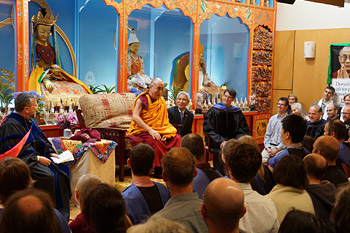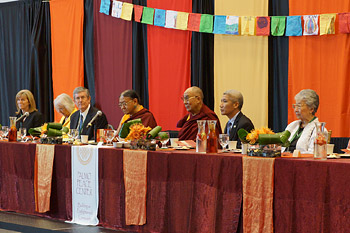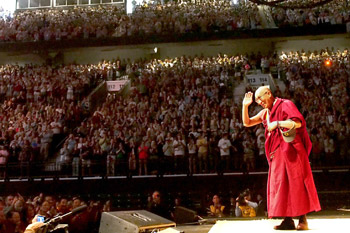Life after Life Symposium at Maitripa College and Talk on Path to Peace and Happiness in Eugene
Portland, Oregon, USA, 10 May 2013 - Maitripa College is a Tibetan Buddhist College founded in 2005 in Portland, Oregon. Since 2008, it has been able to award degrees and today His Holiness the Dalai Lama was the special guest during such a commencement ceremony. The sunlit streets outside were filled with well-wishers who waved and called out to His Holiness as he was met at the door by founding President Yangsi Rinpoche. Escorted briskly around the college, he was shown the various facilities before entering the Jokhang or main hall where he viewed the sacred images and paid his respects before taking his seat. Oregon Office of Degree Authorization representative Jennifer Diallo gave a short welcoming talk in which she introduced Maitripa College and explained the criteria for proper authorization of degrees.
A short symposium followed on the theme ‘Life after Life’. Neuroscientist and author of ‘Proof of Heaven: A Neurosurgeon's Journey in the Afterlife,’ Dr Eben Alexander began with an account of his personal experience. Four and a half years ago he fell into a coma as a result of developing acute meningitis. During this time he experienced a far grander awareness that he attributes to his mind being temporarily freed from the limits of his brain. The experience entirely transformed his view of past and future lives and the mind’s potential. 
| His Holiness the Dalai Lama speaking at Mairtripa College in Portland, Oregon on May 10, 2013. Photo/Jeremy Russell/OHHDL
|
Dr José Cabezon, a Buddhist scholar then spoke about reincarnation from an academic perspective. The notion of rebirth is strong in India and yet there is little mention of it in the ancient texts known as the Vedas. There are inklings of it from 8th century BCE and it is referred to more explicitly in subsequent Buddhist literature. Some Indian scholars attempted to prove rebirth on the basis of reason and on the basis of experience. Dharmakirti, for example, responding to materialist challenges, asserted that consciousness was not of the same nature as matter and exists in its own continuity. Empirical accounts of recollections of previous lives were rare in India because, as in the case of Atisha, the Indian master who came to Tibet in 11th century, such things were regarded as private and not to be revealed. Tibetans however took a different view and Dr Cabezon noted accounts in the works of the 3rd Karmapa of events in the life of the first in his lineage, Dusum Khyenpa.
His Holiness took up the theme commending the reliability of scientific research on the one hand, but noting on the other that there are some phenomena, rebirth perhaps among them, that are beyond its capacity to investigate. He mentioned three kinds of phenomena, evident, hidden and extremely hidden, saying that science generally deals with what is evident, but on the basis of inference also touches on hidden phenomena. The third class, extremely hidden phenomena, with regard to the mind, is only available to someone’s subjective experience. It then becomes a matter of testimony, whose reliability depends on the credibility of the informant. His Holiness was careful to point out that something’s being beyond science’s ability to investigate is not the same as science’s proving it not to be so.
“My own observation,” he said, “is that science is beginning to explore the importance of our various mental states. I’ve been having serious conversations with scientists for more than 30 years and these investigations are still in the initial stages. Trying to formulate a theory of consciousness, which is a very subtle phenomenon, only on the basis of a material organ, the brain, is problematic. So too are scientific investigations of animal brains, which are far smaller and different from human brains.”
His Holiness referred to the 300 volumes of Buddhist literature translated mostly from Sanskrit into Tibetan, which can be classified as dealing with Buddhist science, philosophy and Buddhist practice. He said that while those books dealing with Buddhist practice were only of concern to Buddhists, the volumes that deal with science and philosophy can be studied academically by themselves. And it is these texts that contain a wealth of knowledge about the mind and its functions and the workings of our emotions that may be of interest to modern scientists today.
Concluding his remarks, His Holiness expressed his pleasure that Maitripa College has become a centre of learning, recalling that this is what distinguished the ancient Indian University of Nalanda. Yangsi Rinpoche then offered him an Honorary Degree without further ado.

| His Holiness the Dalai Lama during a luncheon to mark the launch of the Palmo Peace Center at the University of Oregon in Eugene, Oregon on May 10, 2013. Photo/Jeremy Russell/OHHDL
|
Next, His Holiness took a short flight from Portland to Eugene and was received at the airport by Sakya Gongma Rinpoche, Ngalo Rinpoche and Jigme Rinpoche, who then drove with him to the University of Oregon. There he was welcomed to a lunch reception hosted by the University of Oregon and Nyengyud Samten Choling to mark the launch of the Palmo Peace Center. In his remarks at the end of the meal, His Holiness said:
“I am very happy to be here with you all. The aims of this Peace Center are good and it will be helpful if it is able to work for peace without necessarily teaching explicitly about Buddhism. The main message, which people of any faith or none, can learn from, is the importance of love and compassion.”
Welcomed to the Matthew Knight Arena by Ven Tulku Jigme His Holiness was introduced to the audience of 10,000 by University of Oregon President Michael R. Gottfredson, who also awarded him the President’s Medal.
“I always start my talks by greeting my brothers and sisters, because I feel it is important to note that we are all the same kind of human beings,” His Holiness began. “Despite outward differences between us we are physically, mentally and emotionally the same. You have the potential to exercise good emotions and bad emotions, and I do too. We all want to live a happy life free from trouble and disturbance and we all have a right to do so.
“I express my strong belief in the oneness of humanity wherever I go. When we examine our situation in the world, we see that natural disasters are beyond our control, but the violence, injustice and poverty that many of us face are problems that we have created ourselves.
“When I look at any of you I see another human being, but if I think of you as a foreigner, or I think of myself as a Tibetan, a Buddhist or a holy person with the name Dalai Lama, all of them secondary differences, it creates a barrier between us that can lead to isolation and so to loneliness.”
He said that there is often a huge gap between what we perceive and reality, and if we act only on what we perceive to be the case, our action becomes unrealistic. We need to take a much more holistic view, which involves training and education.
An example of the gap between our perception and reality is our tendency towards self-centredness. At a meeting in New York, His Holiness heard a scientist describe findings that people who use the words I, my and mine more often than usual are more prone to suffering a heart attack. The opposite of self-centredness is compassion and concern for others, which allow us to build our inner strength, to reinforce our self-confidence. This leads to greater honesty and transparency which makes for a warmer, friendlier atmosphere. To think that compassion is related only to religious practice is a mistake; it’s a basic human value that derives from the affection we receive in childhood from our mothers.

| His Holiness the Dalai Lama waving to the audience of over 10,000 people at University of Oregon's Matthew Knight Arena in Eugene, Oregon on May 10, 2013. Photo/Kurt Smith
|
Next, His Holiness asked the audience for a show of hands to indicate their age - asking who’s less than 15, less than 20, less than 30? And who’s older than 70, than 60? He said that those more than 60 years old, like him, belong to the twentieth century, a century that is past. Meanwhile, those younger than 30 truly belong to the twenty-first century and have the opportunity to shape this new era. Expressing appreciation of the twentieth century’s many achievements, he noted that it was also a period of immense violence and bloodshed, a period in which some historians have estimated more than 200 million died violently. The great mistake of the time was the attempt to solve problems by force, when the only real way to solve them is by talk, through dialogue.
“The younger generation today has the opportunity to change the shape of the future, to create a friendlier, more peaceful, happier world. This will not be achieved just through prayer and meditation, although of course as a Buddhist monk I practise prayer and meditation myself. In terms of changing the world community we need to take action, by adopting a realistic goal, a realistic vision. Among such goals is the prospect of a demilitarised world.”
In this context, he said, we have to re-examine our education system. Modern education at present only concerns the intellect and ignores the heart. The time has come to pay more attention to our inner values. We need to promote the role of compassion in our affairs and because of that women should take a more active role as leaders. His Holiness declared that whatever sense of compassion he has is rooted in the kindness of his mother. He appealed to his listeners likewise to show their children affection and to spend more time with them.
“It’s been a great honour to be here.” he said, “Don’t take it for granted that your future will be good. Take a wider perspective; develop a holistic view taking account of others’ well-being. You need determination and an optimistic outlook; low morale and pessimism are a source of failure. Wisdom and warm-heartedness are the source of success.”
And, waving to the audience in all four quarters of the arena, he left the stage to rousing cheers and applause.  http://www.dalailama.com
|